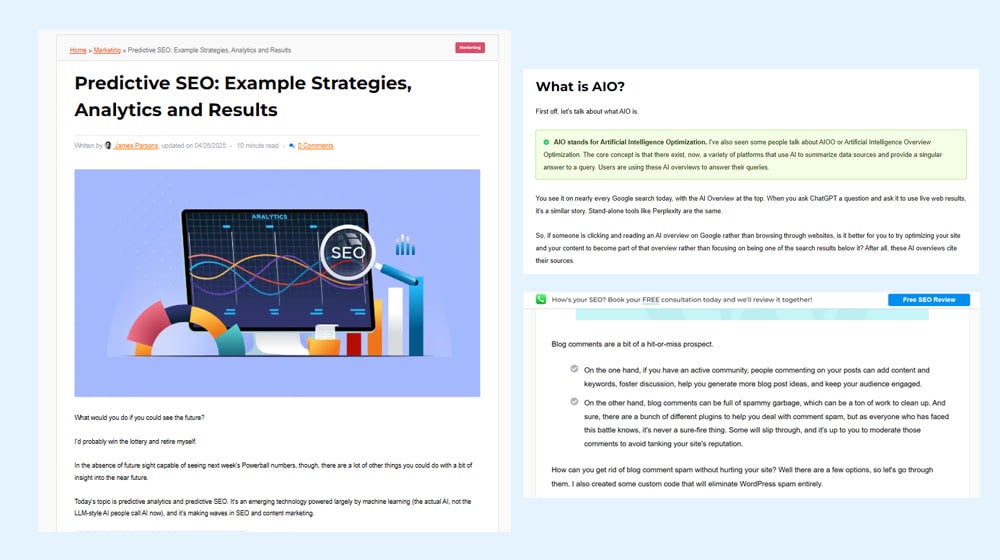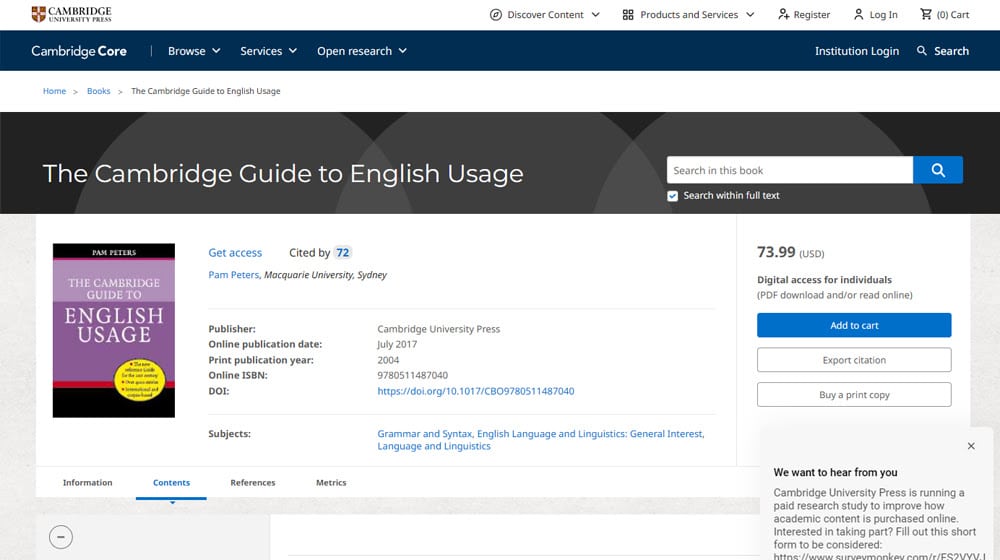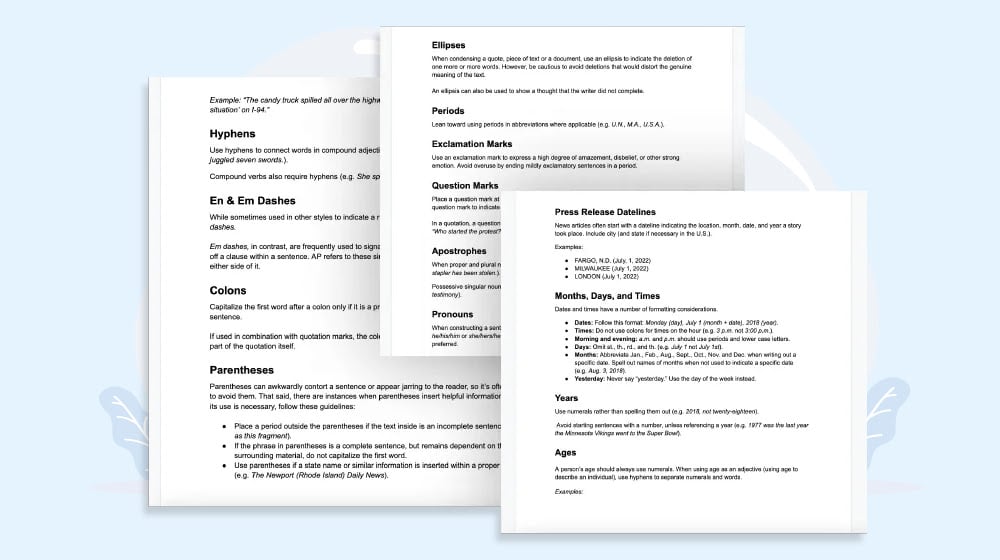How to Create a Style Guide for Your Website Writers

Some website owners do everything themselves, but a lot more realize that's not really sustainable as a business grows and your ambitions get bigger. Content marketing for a large enough website can be a full-time job. For others, just one full-timer won't cut it.
When you reach the point where you have multiple people creating content for your site, you have a significant question you need to answer: are you going to have a style guide, and if so, what will you have in it?
It's an interesting discussion and one that comes with a lot of additional questions worth considering, so let's go through it.
Should You Have a Website Style Guide?
A website style guide is effectively a branding document. It's a set of rules for the creation of content for your site that anyone you hire to work with will need to follow.
At a higher level, you might have a brand style guide or brand guidelines document, but that's not quite what we're talking about today. Brand guidelines have more to them, including things like how your logo is allowed to be used, what aesthetic and color choices should be used for your site's graphic design, and so on. A writer's style guide is narrower and refers specifically to text created for your blog.
For a writing style guide, it's all about specifying the little details that make your blog what it is. We're talking voice, perspective, tone, and other elements of writing. It can also specify rules like "don't mention X brand," so you don't mention or link to direct competitors, or "have a positive outlook on Y brand," so you can glaze your partners a bit, and so on.

In my time working with businesses and running blogs, I've seen writer guides that are half a page long, and I've seen others that are 20-page PDFs covering so many niche cases it's nearly impossible to track. I suspect you can guess which side I tend to prefer.
I will say this upfront: there's no wrong answer here. If you want to forsake a style guide and let your writers have their own voices, feel free. If you want a lightweight style guide that covers the big elements of style but leaves the rest up to the professional, great. If you want a heavy-duty style guide enforcing brand standards across a fleet of freelancers, that's up to you.
There are, however, pros and cons to style guides, so let's go over those.
The Pros of a Style Guide
What are the benefits of having a style guide for writers for your website?
It ensures a consistent voice for your content. There are a lot of websites out there where there's one author creating content, but there are actually as many as half a dozen or more different people actually doing the writing and editing of that content.
When you have a bunch of different people writing content for a site, they all have their own quirks, their idiosyncrasies, and their own developed styles. A style guide helps put them all on the same page, so the person whose name is attached to them all comes across as having a consistent voice.
Even if your writers aren't ghostwriting, having everyone on your site produce content with a consistent voice helps build up your overarching brand. Certain kinds of publications benefit from this more than others, especially sites aiming for more casual, irreverent, or artistic tones.

It can answer common questions to enhance turnaround times. During the process of writing content for a new site, a lot of little questions can come up. Sometimes, a writer can answer those questions by looking at existing content, but sometimes, they either can't or don't and prefer to ask their editor or manager directly. But, if the answers to those questions are already in the style guide, they can just reference the document. This cuts down on back-and-forth communication and delays, as well as post-delivery editing and revisions.
It speeds up onboarding for new writers and contributors. Whether you're hiring random freelancers from a content mill, rotating through writers as they come and go, or frequently bringing in guest contributors, having a style guide gives them a place to start and speeds up training and onboarding. It leaves more time for the other paperwork and lets them get to work faster.
The Cons of a Style Guide
What about the other side of the coin? Are there downsides to using a style guide?
It can turn off good writers. There are a lot of excellent writers out there who have developed their own styles over their years of work in the field. If they want to work for you, but they're confronted with a dense and strict style guide, they might choose not to take the job after all.
Basically, it's a lot of added burden for people who, ostensibly, you're trusting to do the work and produce a good output for your brand. That said, this con is more about the long and strict style guide; the simple guides with a handful of rules are much easier to adopt and, for many professional writers, essentially considered the basics anyway.

It creates an added burden for an editor. For smaller brands, especially, if you're both the owner and the managing editor, using a style guide can actually generate more work for you. At least, it can for a while until you trust the writer to be following it.
This is because when you have a style guide in play, you need to verify that it's being followed. That means making sure all of the rules are implemented properly. That's not a huge burden if it's simple, like "use first-person singular POV," but it's a lot trickier if you have to go through and edit for commas and spacing and word choice and all the rest.
You can offload some of this to tools, but not necessarily all of it, and a human eye is always a good idea when you're reviewing content you're putting under your brand name.
They can be rigid and locked in. I often look at the content I wrote 3-4 years or more ago, and it feels like something a totally different person wrote because my voice evolves with my experience. If I was rigidly following a style guide, it would inevitably start to chafe, and it would stifle some of the more creative ways I've used language throughout my blog.
You can get around this by keeping the style guide updated over time, but that's yet another administrative task you have to keep on top of while running your site, and it's very easy for it to slip through the cracks over time.
Picking the Type of Style Guide
For the purposes of this post, I'm going to assume you've decided that you want to have a style guide despite the potential drawbacks. So, your first choice is to pick what kind of style guide you want to use.
Option 1: The External Guide
The basic choice a lot of brands make is to pick a style guide that already exists.

There are a bunch of these:
- An ISO guide: ISO has a dozen style guides for different purposes.
- The Cambridge Guide to English Usage, the Cambridge University Press style guide.
- Strunk and White's Elements of Style, a guide first published in 1918.
- The AMA Manual of Style, used for medical papers and publications.
- The Chicago Manual of Style, often referenced as one of the premier online writing styles.
- The APA Style Guide, one of the most forward-thinking and inclusive style guides.
- The AP Stylebook, the style guide used by the Associated Press.
This is just a short list; there are dozens, or even hundreds, if you count international style guides and industry-centric style guides.
There are three major downsides to using one of these style guides.
The first is that they're generally very long. The AP Stylebook, for example, is over 600 pages long. These kinds of guides are overkill for most small businesses, and the only reason they can be effective is that 90% of the content in them is irrelevant, and most of the remaining 10% is stuff your writers might already know.
The second is that they're often made for other kinds of writing, like press journalism, technical papers, or academic writing. Very few style guides are meant for web writing, and the trends in web writing evolve a lot faster than the style guides change.
The third – and most important – is something that becomes clear if you click some of the links above. They're expensive. A style guide book might cost $50, and that's a pretty significant requirement for a writer you're hiring. Sure, you could provide it for them, but you still need to buy it.
Option 2: The Piggyback Guide
The second option is a piggyback guide. These usually start with something like "We generally follow the AP Style Guide, but with the following modifications."

On one hand, this gives your writers a baseline if they're familiar with that source style guide. It also gives them some idea of what you consider important enough to make as your modifications. On the other hand, if they aren't familiar with the core style guide, they'll either ignore it and just pay attention to your modifications, or they face all of the burden of learning a new, huge style guide.
Option 3: The Lightweight Guide
The first real option, in my opinion, is the lightweight style guide. These are guides that are maybe 1-2 pages long and encompass the basics. They specify things like voice, tone, POV, general target word count, how you manage links, and other basics. I'll talk more about what goes into a style guide later.

The benefit of these style guides is their simplicity while still allowing creative freedom. They help ensure that your site's tone is consistent but let the writers express themselves.
Option 4: The Heavy-Duty Playbook
The last option is making something akin to an official style guide but for yourself. In a way, this is what the Associated Press stylebook is; it's the style guide made for the Associated Press itself. It has just grown far beyond that original purpose over the decades.

I will say that even the most ambitious brands tend to end up with a style guide around 10 pages long, and a lot of it is either meaningless edge cases or redundant. If that's what you want to maintain, go for it, but I find it to be unnecessary in most cases.
What Goes Into a Website Style Guide for Writers?
So, if you're putting together your own style guide, what should it include?
Key overall values and guidelines. For example, you could say:
- "Regardless of specifics, consistency is the key. If you use the oxford comma, use it every time."
- "Familiarize yourself with our brand core values and keep them in mind while writing."
- "Pay attention to X, Y, and Z brand names and trademarks to use them properly."
Basically, if it's important enough that you would have an editor pay attention to it specifically, you should write it down.
Your POV. The POV of your writing is essentially how personal your writing is.
- 1st person singular: "I think this, and I've found that…"
- 1st person plural: "We believe this, and we've found that…"
- 2nd person: "You might think that X, but really, you'll discover that Y…"
- 3rd person: "When they do X, Y happens…"
There are variations, and there are some blurred lines between them, particularly with web writing. For example, I consider my blogging mostly to be in the first person singular (like how I used I in this sentence), but when I'm talking to you, it might seem like it's second-person.
Usually, web writing is either first person singular when you're ghostwriting for an individual, first person plural when you're writing for the collective brand, and third person when the brand wants a more detached and clinical tone.

Brand consistency and editorial guidelines. These are details like whether or not you want to specify the use or disuse of the Oxford comma, how you capitalize brand names, including your own, how you handle abbreviations and acronyms, how you include links and citations, and so forth. Even details like whether you use title case for H2s and H3s can be part of it.
This can also include details like whether or not your writers should make jokes, reference memes, or even take political stances. All of this contributes to your overall brand voice.
Technical details. These can be little things like whether or not you want to avoid terms like blackhat/whitehat in favor of more inclusive terms, what kinds of industry acronyms you assume are basic knowledge and don't need explaining, any key competitors to avoid or resources to cite preferentially, and that kind of thing.
There are also other details you might include, like audience demographics and search intent, but these can also go in your content brief, which will have some overlap with a style guide.
Over time, you'll find that some elements of your style guide might end up outdated and need changing. You might also encounter questions from writers that you want to add to the guide. Don't be afraid to edit the style guide; it's meant to be a living document that represents what you want your output to look like.
Do you already use a style guide? Are you thinking of making one? Tell me your stance in the comments!










Comments